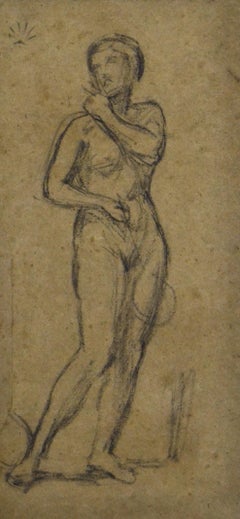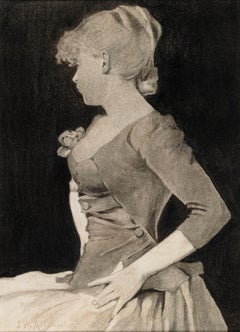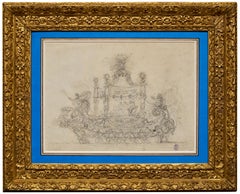Albert Joseph Moore Drawings and Watercolor Paintings
to
1
Overall Width
to
Overall Height
to
1
1
1
1
1
1
1
1
922
406
282
279
1
1
Artist: Albert Joseph Moore
Study for Battledore & Shuttlecock - British Aesthetic Movement drawing
By Albert Joseph Moore
Located in London, GB
ALBERT JOSEPH MOORE, ARWS
(1841-1893)
Study for Battledore & Shuttlecock
Signed with anthemion
Chalk on brown paper
27 by 13 cm., 10 ½ by 5 in.
(frame size 49 by 34.5 cm., 19 ¼ b...
Category
1870s Aesthetic Movement Albert Joseph Moore Drawings and Watercolor Paintings
Materials
Chalk
Related Items
Silhouette of a Young Girl
By John White Alexander
Located in Bryn Mawr, PA
Silhouette of a Young Girl
Charcoal on paper
14 1/2 x 10 3/4 inches (36.8 x 27.3 cm)
Signed lower left: J.W. Alexander
Provenance
Grand Central Art Galleries, New York;
Samuel B. an...
Category
Late 19th Century Aesthetic Movement Albert Joseph Moore Drawings and Watercolor Paintings
Materials
Paper, Charcoal
A dazzling Venetian Regatta Boat Study attributed to Alessandra Mauro
Located in PARIS, FR
This stunning Baroque study depicts a regatta boat, a type of vessel developed in eighteenth-century Venice for the regattas organized by the Serenissima during visits by royalty and princes. We propose to link this drawing to the work of Alessandro Mauro, an artist who specialized in this type of composition, as illustrated by a drawing from him at the Metropolitan Museum.
1. Description of the boat
The greatest decorative fantasy reigns in this preparatory study, which blends mythological and exotic elements with references to ancient Egypt. Our drawing is probably an initial thought, destined to be refined and clarified later in pen and ink (as evidenced by the ink stain in the lower right). A quadriga of seahorses guided by Neptune stands at the stern of the boat, shown well above the waterline (perhaps to outline its empty volume). One of the seahorses is ridden by a newt, while Amphitrite lies at the feet of the sea god.
The center of the boat is occupied by a vast baldachin resting on four atlantes and surmounted by a figure riding an animal (a dragon?). Three figures sit beneath the canopy, one of them on a griffin-shaped seat. This allusion to Egyptian antiquity echoes the winged sun (sometimes a symbol of the god Horus, as in the temple of Edfu in Egypt) that adorns the sides of the promontory on which this baldachin rests.
Another flag-bearer figure crouches at the stern of the boat on a raised seat, on the reverse of which is a crowned mermaid whose arm, extended backwards, rests on a mascaron decorated with a radiant face (Helios?) and whose torso surmounts an elephant's head. The heads of the rowers and their oars are sketched all along the boat, whose sides are embellished with elongated naiads.
2. The Venetian regatta boats
An exhibition held in 2013 at the Ca' Rezzonico (the Venetian eighteenth-century museum) paid tribute to these regatta boats through studies and prints depicting them. The regattas organized by the Serenissima in honor of visiting princes and sovereigns were among the most spectacular ceremonies in Venice. Some important artists of the 18th century contributed to the creation of these extravagant boats which were given exotic names such as bissona, malgarota or peota.
The specialists in this field were Andrea Urbani and the brothers Alessandro and Romualdo Mauro. They were born into a family of theater decorators in Piedmont, but little is known about their detailed biography. Alessandro was the architect of the Dresden opera house and of the St. Samuel Theater in Venice (in collaboration with his brother Romualdo), but also worked as stagehand and set designer in Vienna, Rome and Turin. A drawing produced around 1737 from the Metropolitan Museum (7th photo in the gallery) bears witness to his activity as a regatta boat designer.
This drawing is a much more elaborate version than the one presented here, having been entirely reworked in brown ink. However, a figure at the bow of the boat, executed solely in black chalk, still bears witness to a technique similar to that of our drawing.
It is difficult to know whether the boat depicted in our drawing was a project for an actual boat or whether it remained in the planning stage, but the front of our boat (Neptune and the quadriga of seahorses ridden by a newt) bears several similarities to that of a parade boat depicted in the print published by Michele Marieschi entitled Regatta on the Grand Canal, between the Foscari and Balbi Palaces (last photo in the gallery). This print is dated 1741, which could confirm that our work dates from around 1740.
The area between Neptune and the quadriga that precedes him on this strange paddle-boat appears to be partially submerged, confirming that the waterline of our boat was probably intended to be much lower than the one shown in our drawing.
The Correr Museum’s collection holds one of the most important collection of engravings and drawings devoted to these specifically Venetian Baroque productions. These boats were intended to last the duration of a festival. Today, they are only documented by preparatory drawings or prints that testify to the sumptuousness of their decoration. This taste for regatta boats lasted throughout the Venetian eighteenth century, and the conception of regatta boats also attracted great masters such as Giambattista Tiepolo, Francesco Guardi or Giambattista Piranesi...
Category
Mid-18th Century Old Masters Albert Joseph Moore Drawings and Watercolor Paintings
Materials
Chalk
$4,604
H 15.75 in W 19.25 in
Leaning Nude Man (recto); Kneeling Man, Hands Tied Behind His Back (verso)
By Giovanni Francesco Barbieri (Il Guercino)
Located in Paris, Île-de-France
GIOVANNI FRANCESCO BARBIERI, known as GUERCINO
(1591-1666)
Leaning Nude Man (recto); Kneeling Man, Hands Tied Behind His Back (verso)
Black chalk heightened with white on light blu...
Category
1620s Old Masters Albert Joseph Moore Drawings and Watercolor Paintings
Materials
Chalk, Charcoal
$80,000 Sale Price
20% Off
H 18.12 in W 13.98 in
Life study of a male nude in repose - European School, late 18th Century
Located in Middletown, NY
European School, late 18th century. Red chalk with primo pensiero in graphite on cream laid paper, 8 1/2 x 11 1/2 inches (215 x 293 mm). Scattered light handling wear and multiple s...
Category
Late 18th Century Naturalistic Albert Joseph Moore Drawings and Watercolor Paintings
Materials
Chalk, Laid Paper, Pencil, Graphite
Mid Century Nude Figure Study of a Black Woman
By Raul Anguiano
Located in Soquel, CA
Compelling mid century nude figure study of a black woman reclining by Raul Anguiano (Mexican/American, 1915-2006), 1968. Signed and dated lower left hand corner "R. Anguiano." Presented in wood frame under plexiglass. Image size: 25"H x 34"W. Framed size: 35"H x 43.75"W.
Raúl Anguiano was born in Guadalajara, Jalisco, on February 26th, 1915. He started drawing cubist pictures at the age of 5, taking as his first models movie stars, as Mary Pickford, Pola Negri and Charlie Chaplin. Anguiano first artistic influence or aesthetic emotion came from the Holy Family by Rafael Sanzio.
At the age of 12, Anguiano attended Guadalajara's Free School of Painting under the tuition of Ixca Farias. From 1928 to 1933, he studied with the Master painter José Vizcarra, the disciple of Santiago Rebull and José Salomé Piña, and organised the group "Young Painters of Jalisco" with other artists. During this period, Anguiano worked with different kinds of models: workmen, employees and a few intellectuals like Pita Amor.
In 1934 Anguiano moved to Mexico City. He began teaching in primary schools and taught drawing and painting at La Esmeralda academy and the UNAM School of Art.
Anguiano was a member of the Mexican Artistic Renaissance movement which was started in the 1920's by the Mexican School of Art in which he belonged. This renaissance began with the San Carlos Academy movement -- among whose leaders were Ignacio Asúnsolo and Jose Clemente Orozco -- and which emerged out of the students' and teachers' discontent with the traditional paintings methods (academicism), and the close contact that the young artists had with the problems of Mexico and its people, explaining the marked critical realism to the painters of the time, including Anguiano himself.
The same year, Anguiano received a commission to paint his first mural, Socialist Education, a 70 meters fresco located at A. Carrillo School in Mexico City. Other works followed, including Mayan rituals (oils on canvas and wood), for the Mayan Hall in the National Museum of Anthropology, and Trilogy of Nationality (acrylic on canvas and wood), for the Attorney General's Office.
In 1936 he moved into his surrealist period, which lasted almost a decade. He painted circus performers and prostitutes. The most notable among his works of the time are: The Madame (gouche, 1936), The Clown's Daughter (oil, 1940), the Pink Circus Artist and the Grey Circus Artist (oil, 1941). Also during this period, Anguiano produced a series of drawings based on his dreams, with cold tones and silver-greys predominating.
In 1937 Anguiano joined the Revolutionary Writers and Artists League. Together, with Alfredo Zalce and Pablo O'Higgins, he was also a founding member of the Popular Graphics Workshop, where artists practised a graphic style based on Mexico's folk traditions. This was due to the powerful influence of the recently discovered Jose Guadalupe Posada and Goya.
Raúl Anguiano belonged to the so-called "Third Generation" of post-revolutionary painters, along with Juan O'Gorman, Jorge González Camarena...
Category
1960s Realist Albert Joseph Moore Drawings and Watercolor Paintings
Materials
Paper, Conté, Charcoal
$4,400 Sale Price
20% Off
H 35 in W 43.75 in D 2 in
France circa 1820, Portrait of a gentleman, black chalk and pastel drawing
Located in Paris, FR
France circa 1820
Portrait of a gentleman
Black chalk and pastel on paper
12 x 10 cm
In its original mount, modern oak frame : 25 x 22.5 cm
Category
1820s Romantic Albert Joseph Moore Drawings and Watercolor Paintings
Materials
Pastel, Chalk
$813
H 4.73 in W 3.94 in
HUMAN ATMOSPHERE Retro-study 5 - contemporary artwork, emerging artist
By Michael Pemberton
Located in London, GB
In this collection, British painter Michael Pemberton (b. 1974) suggests we each have a personal HUMAN ATMOSPHERE. An ether where we truly exist, unseen by the naked eye but as real ...
Category
21st Century and Contemporary Abstract Albert Joseph Moore Drawings and Watercolor Paintings
Materials
Chalk, Charcoal
$2,870
H 30 in W 19 in D 1.5 in
Cat - Drawing by Novella Parigini - 1970s
Located in Roma, IT
Cat is an artwork realized by Novella Parigini (Chiusi 1921 - Rome 1993)
Polychrome chalk on black paper.
83x63 cm frame included.
Hand signed in t...
Category
1970s Contemporary Albert Joseph Moore Drawings and Watercolor Paintings
Materials
Chalk
Portrait of Leopold Myers by Sir William Rothenstein
By Sir William Rothenstein
Located in Soquel, CA
Stately sanguine portrait of Leopold Hamilton Myers (Novelist) by Sir William Rothenstein (English, 1872-1945). Captured in Rothenstein's characteristic style, Myers looks directly at the viewer with a neutral expression. Although this portrait uses only two colors and minimal shading, the likeness of Myers is incredibly well captured. Leo (Leopold) Hamilton Myers (1881 – 1944) was a British novelist. Numerous examples like this one of the writer are in the Tate Museum.
Initialed and dated in the lower right corner ("W.R. 1936")
Inscription on verso indicating materials, subject, and artist.
Presented in a new cream colored mat with foamcore backing.
Mat size: 18"H x 12"W
Paper size: 15.25"H x 10.75"W
William Rothenstein (English, 1872-1945) was born into a German-Jewish family in Bradford, West Yorkshire. His father, Moritz, emigrated from Germany in 1859 to work in Bradford's burgeoning textile industry. Soon afterwards he married Bertha Dux, and they had six children, of which William was the fifth. Rothenstein was knighted in 1931.
Rothenstein left Bradford Grammar School at the age of sixteen to study at the Slade School of Art*, London (1888-1893), where he was taught by Alphonse Legros, and the Académie Julian* in Paris (1889-1893), where he met and was encouraged by James McNeill Whistler, Edgar Degas and Henri Toulouse-Lautrec. Whilst in Paris he also befriended the Anglo-Australian artist Charles Conder, with whom he shared a studio in Montmartre. In 1893 he returned to England to work on "Oxford Characters" a series of lithographic* portraits.
In Oxford he met and became a close friend of the caricaturist* and parodist Max Beerbohm, who later immortalised him in the short story Enoch Soames (1919). During the 1890s Rothenstein exhibited with the New English Art Club* and, in 1900, won a silver medal for his painting The Doll's House at the Exposition Universelle. In 1898 he co-founded the Carfax Gallery in St. James' Piccadilly with John Fothergill. During its early years the gallery was closely associated with such artists as Charles Conder, Philip Wilson Steer, Charles Ricketts and Augustus John. It also exhibited the work of Auguste Rodin, whose growing reputation in England owed much to Rothenstein's friendship and missionary zeal. The gallery was later the home for all three exhibitions of The Camden Town Group*, led by Rothenstein's friend and close contemporary Walter Sickert.
Rothenstein is best known for his portrait drawings of famous individuals and for being an official war artist in both World War I and World War II. He was also a member of the International Society of Sculptors, Painters & Gravers. The style and subject of his paintings varies, though certain themes reappear, in particular an interest in 'weighty' or 'essential' subjects tackled in a restrained manner. Good examples include Parting at Morning (1891), Mother and Child (1903) and Jews Mourning at a Synagogue (1907) - all of which are owned by the Tate Gallery. The National Portrait Gallery owns over two hundred of his portraits. In 2011 the BBC and the Public Catalogue Foundation began cataloguing all of his paintings in public ownership online.
Between 1902 and 1912 Rothenstein lived in Hampstead, London, where his social circle included such names as H.G.Wells, Joseph Conrad and the artist Augustus John. Amongst the young artists to visit Rothenstein in Hampstead were Mark Gertler...
Category
1930s Realist Albert Joseph Moore Drawings and Watercolor Paintings
Materials
Conté, Handmade Paper
$2,112 Sale Price
35% Off
H 18 in W 12 in D 0.25 in
Sketch for a Sculpture - Original Drawing - Early 20th Century
Located in Roma, IT
Sketche for a Sculpture is an original Pencil and Pastel realized by Charles Moulin in early-20th Century.
Good condition on a little brown paper.
No ...
Category
Early 20th Century Modern Albert Joseph Moore Drawings and Watercolor Paintings
Materials
Pencil, Chalk
$717
H 6.5 in W 3.15 in D 0.08 in
Interior - Original Pencil and Chalk on Paper - Early 20th Century
Located in Roma, IT
Interior is an original drawing in pencil on paper, realized by unknown artist of the early 20th Century.
Sheet dimension: 25 x 32.5
The state of preservation is very good but aged...
Category
Early 20th Century Modern Albert Joseph Moore Drawings and Watercolor Paintings
Materials
Pencil, Chalk
$239
H 9.85 in W 9.26 in D 0.04 in
Riptide Study, Danny Galieote, Conte and Gouache, Figurative, Americana Pop
By Danny Galieote
Located in Laguna Beach, CA
DANNY GALIEOTE
Riptide Study
Conté and Gouache on Archival Paper
30 x 24 1/2 inches, Framed
Danny Galieote has a propensity for capturing the quintessentials of Americana in works that blend realist narratives with a pop sensibility. The works are reminiscent of classic, vintage postcard imagery with an undercurrent of poetic, and often surprising, juxtaposition. The stylistic effect is a blend between the old-school charm of Norman Rockwell, with the unexpected twist of surrealist René Magritte. JoAnne Artman Gallery is pleased to present an exhibition of new works by Danny Galieote with a focus on iconic American summertime scenes.
Galieote belongs to a group of contemporary artists and writers that are part of a revitalized interest in American regionalist history and art. The American Regionalist art...
Category
2010s Contemporary Albert Joseph Moore Drawings and Watercolor Paintings
Materials
Conté, Gouache, Archival Paper
$3,150 Sale Price
30% Off
H 30 in W 24.5 in D 2 in
Albert Joseph Moore drawings and watercolor paintings for sale on 1stDibs.
Find a wide variety of authentic Albert Joseph Moore drawings and watercolor paintings available for sale on 1stDibs. You can also browse by medium to find art by Albert Joseph Moore in chalk and more. Not every interior allows for large Albert Joseph Moore drawings and watercolor paintings, so small editions measuring 6 inches across are available. Albert Joseph Moore drawings and watercolor paintings prices can differ depending upon medium, time period and other attributes. On 1stDibs, the price for these items starts at $4,385 and tops out at $4,385, while the average work can sell for $4,385.


